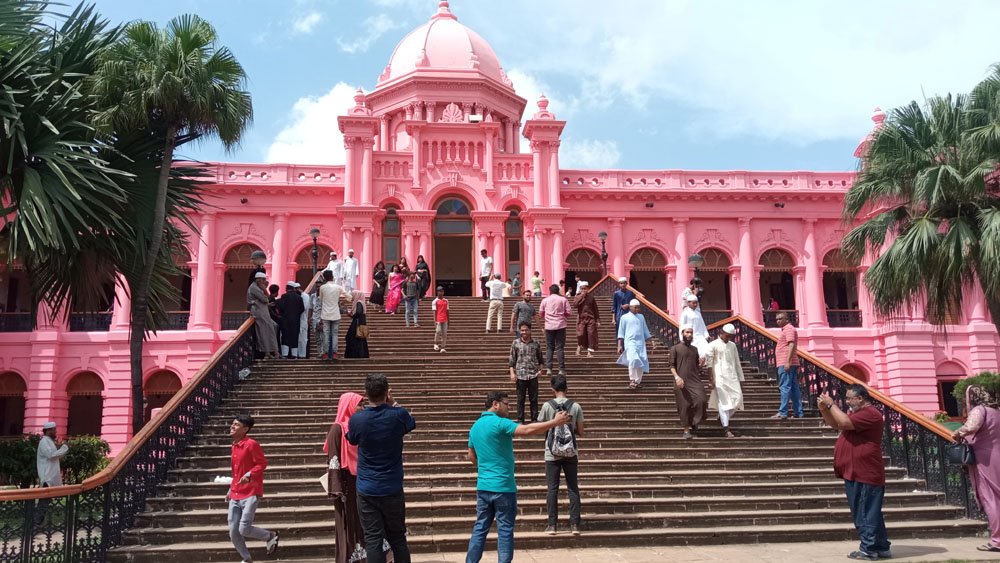Ahsan Manzil- Tourist attractive place

Ahsan Manzil- Museum, photos, history, visiting hours, off day, on day, Ticket price for Bangladeshi people and SAARC related country and others country, tips on visiting, FAQ and every others details of Ahsan Manzil (Called Pink Palace) . The grand Places are located in old Dhaka near by Burighanga River.
Ahsan Manzil, also known as the Pink Palace, is an iconic architectural landmark nestled on the banks of the Buriganga River in Dhaka, Bangladesh. Its name, “Ahsan Manzil,” translates to “Palace of Grace” in English, aptly capturing the grandeur and elegance of this historic structure.Constructed in the late 19th century, Ahsan Manzil served as the official residential palace of the Nawabs of Dhaka. The palace was commissioned by Nawab Abdul Ghani, the city’s prominent ruler of that era, and it stands as a testament to the rich cultural heritage and architectural prowess of Bangladesh.Throughout its storied history, Ahsan Manzil has witnessed significant political and social changes, reflecting the evolving landscape of Bangladesh. It served as a symbol of power and prestige during the Nawabi era, witnessing extravagant celebrations, royal ceremonies, and diplomatic gatherings.
Table of contents:
- The history of Ahsan Manzil
- The early stage of the property
- Acquiring the property by the Nawab Family
- The founding of Ahsan Manzil
- Restoration of Ahsan Manzil
- The Decline of Ahsan Manzil
- A Timeline of Ahsan Manzil
- Ahsan Manjil Visiting Hours
- Ahsan Manzil off day
- Ahsan Manzil ticket
- Ahsan Manzil tricket price
- Ahsan Manzil online ticket
- Ahsan Manzil contact no
- Visiting Ahsan Manzil

Ahsan Manzil (Pink Palace) in old Dhaka few days ago. Photo by @ wonderlushbangladesh.com
The history of ahsan manzil
Ahsan Manzil served as the official residence of the Dhaka Nawabs, the prominent aristocrats of the resion. Throughout its history, the palace witnssed various phases, including renovations, expensions and changes the ownershipdue to shift in political power.
The early stage of the property
The early stages of the Ahsan Manzil property trace back to the late 19th century when it was commissioned by Nawab Abdul Ghani, the then-ruler of Dhaka. The Nawab envisioned a grand residence that would serve as the official palace for himself and his family. Construction began in 1859 and was completed in 1872, marking the culmination of years of meticulous planning and architectural design.
The location chosen for Ahsan Manzil was strategic, situated on the banks of the Buriganga River, which served as a vital artery for trade and transportation in the region. Its proximity to the river not only provided easy access but also added to the scenic beauty of the palace grounds.
The architectural design of Ahsan Manzil was a fusion of various influences prevalent during that period. It reflected the Indo-Saracenic style, characterized by a harmonious blend of Indian, Islamic, and European architectural elements. The palace boasted spacious halls, ornate arches, intricately carved pillars, and majestic domes, all meticulously crafted by skilled artisans of the time.
During its early years, Ahsan Manzil served as the nerve center of the Nawabi court, witnessing extravagant celebrations, royal ceremonies, and diplomatic gatherings. It was not only a symbol of the Nawab’s wealth and power but also a testament to the cultural sophistication of Dhaka.
However, the palace faced its share of challenges, including natural disasters such as the tornado of 1888 and the devastating floods that ravaged the region in 1911. These calamities inflicted significant damage to the structure, prompting extensive restoration efforts to preserve its architectural integrity.
Despite the challenges, Ahsan Manzil remained a beacon of grandeur and elegance, continuing to play a prominent role in the social and political landscape of Dhaka. Over time, it became a cherished symbol of Bangladesh’s cultural heritage, captivating the imagination of visitors and locals alike with its timeless charm and historical significance.

A Side view of the Ahsan Manzil.
Acquiring the property by the nawab family
In Nawab Alibardi Khan’s period around 1740A.D, Sheikh Moti Ullah, the son of sheikh Enayet Ullah, sold the property to the French traders. There was a French trading house beside the property. The trading house became wealthier after purchasing this property. At that time, French trader could do business here without paying any taxes by a decree from the emperor Awrangajeb.
The French became wealthy doing business here in competition with the English and the other European companies. They made a big palace and dug a pond for sweet water in the newly purchased property. The pond still exists in the compound of Ahsan Manjil, which was called “Les Jalla” at that time. In the English French war , the French got defeated, and the English captured all their properties. On the 22nd June on 1757, the French left the trading house with a fleet of 35 boats from the river station of Burigangha in Kumartuli.
In 1758, the English transferred the property to the Frernch trademan named Mr. Champigni and retaken it in 1807. According to the paris agreement of 1814, the French claimed all their left properties at Dhaka, and the 1827 the property was again returned to the French. For the incressuing power of the English, the French were forced to leave the sub-continent. They decided to sell all their properties in Dhaka. So, in 1830, the trading house of Kumartuliwas purchased by all established landlord of Dhaka , Khaja Alimullah.

The Main Gate of Ahsan Manzil (Pink Palace).
The Founding of Ahsan manzil
After some renovation work, the French trading house became the residence of Khwaja Alimullah,. In his time, a stable and a family mosque was added to the compound. After his death, Khwaja Abdul GGhani made a huge development to the property and named it ” Ahsan Manzil” on his son Ahsan Ullah.
On the east side of the old building, he made a new building with a different design and also done great renovation work to the old building. Since then, the old building was called “Ondor Mahal” (The residential house). and the new building was called “Rong Mahal” (The entertainment house).

Restoration of Ahsan Manzil
On the Evening of 7th 1888, a great tornado hit Dhaka city, causing great damage. Ahsan Manzil was great damaged and abandoned. An English engineer from Kolkata arrive here to examinee the palace. He gave the opinion that except for the “Rong Mahal”, all other parts of the palace have to reconstructed.
So Khwahja Abdul Gani and his son Ahsan Ullah turned their full attention to reconstruction the palace.. During that time, both building reconstructed with a new design, made and supervised by the local engineer Gobinda Chandra Roy.
The Old French building were reconstructed to a two storied building keeping similarity to the Rong Mahal. A gangway was made with wood connecting the first floor oif two building. The most beautiful thing made at this time was the doom, Which made the palace so beautiful.

The Decline of Ahsan Manzil
After the death of Khwaja Ahsan Ullah in 1901, the glory of Ahsan Manzil was ended. His successors couldn’t continue the glory for the internal family quarrel. They rented different parts of the palaces tenants, who actually made it a slum. In 1952, government acquired the property and left under the supervision of the Dhaka Nawab Court. In 1985, Dhaka National Museum acquired the property and made it a museum.
A timeLine Of Ahsan Manzil
- Mughal Period : A small entertainment house of Sheikh Enayet Ullah, the feudal landlord of Jamalpur pargana
- 1740 AD : Became a trading house of the French.
- 1757-1785 AD : Became a property of the British.
- 1785-1801 AD: Became a property a French trandsman called Mr. Champigni
- 1801-1827 AD : Property of the british again.
- 1827-1830 AD : Went back to the French traders the Paris agreement of 1814 AD with the british.
- 1830 AD : The French left the india sub-continent . Nowab Alimullah purchased the property and became the residence of the landlord of Dhaka. A new building was built by his son Khwaja Abdul Gani.
- 1888 AD : A great tornado severaly damaged Ahsan Manzil and Khwaja Abdul Gani reconstructed it. The original building was made two storyed and connected with the new building by a wooden gangway. The dome of the entertainment house was added.
- 1952 AD : The feudal land ownership system was abolished. The property went under the control of the government of then Pakintan.
- 1985 AD : Bangladesh government renovated it and opened it as a museum.
Ahsan Manzil Visiting Hours
Ahsan Manzil visiting Hours in During Summer : (April – September) : Saturday – Wednesday 10.30AM – 05.30PM
Friday : 03.00Pm – 07.30PM
Visiting Hour During Winter:
Saturday – Wednesday 09.30AM – 04.30PM
Friday : 02.30Pm – 07.30PM
Visiting Hour in Ramadan : Saturday – Wednesday: 09.30AM – 03.00PM
Ahsan Manzil Off Day:
Ahsan Manzil has one weekly off day throughout the year except for the holy month of Ramadan., When it will have two weekly off days, It also remain closed to visitors during public holidays and Eid days.
Weekly Off Day : Thursday is weekly off day for Ahsan Manzil.
Weekly Off day During Ramadan : Thursday and Friday is off day in Holy month of Ramadan.
Public Holidays : Ahsan Manzil will remain closed to visitors during all public holidays.
Ticket Price :
Ticket Price for Ahsan Manzil : For Bangladeshi visitors 40 Taka fo adult and 20 taka for children. it collect form nearby booth from ahsan manzil . you can buy in online. Now, it available and you will pay 4% service charge.
Visitors from SAARC countries( SAARC means South Asian Association for Regional Cooperation) ticket price for those countries visitors 300 taka per person and Foreigner for others countries without SAARC countries 500 Taka.
Ahsan Manzil contact Number :
![]() 2/3 Islampur Road
2/3 Islampur Road
Dhaka-1000, Bangladesh.
 +880258315954
+880258315954
![]() info@ahsanmanzil.org.bd
info@ahsanmanzil.org.bd
